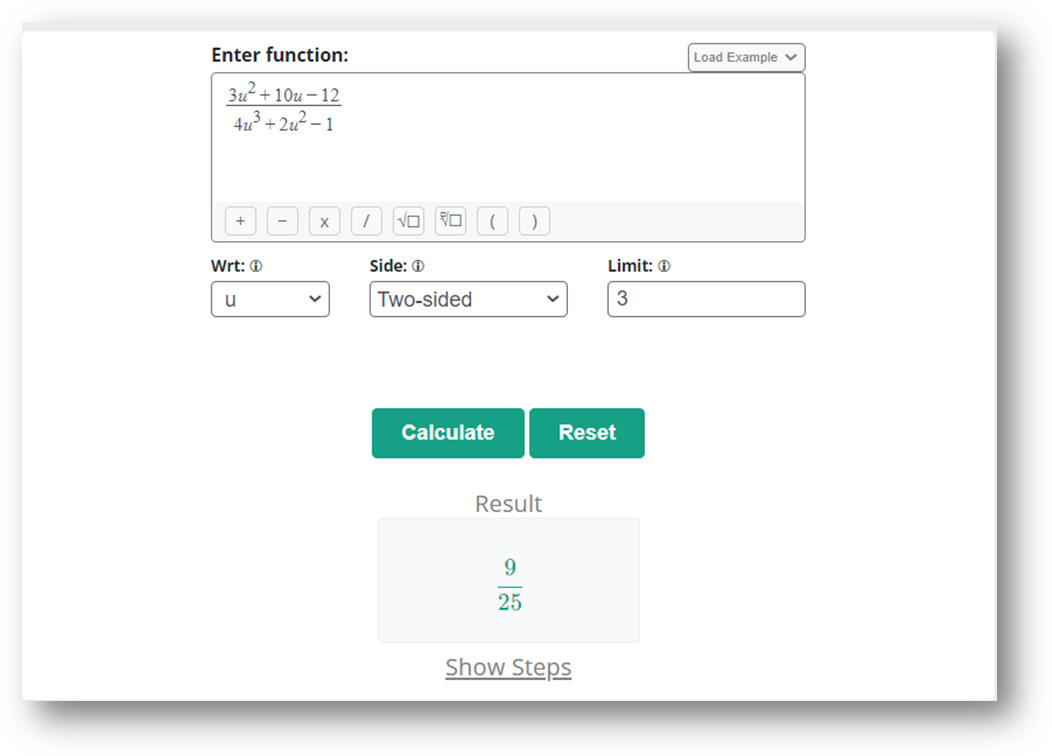Limits in Math: What is it, Its Laws, and Calculations
2023-01-31 | Priyanka Chaudhary
In calculus and mathematical analysis, the term limit plays a vital role in defining the continuity, Taylor series, integrals, and differentiation. Limit is a well-known branch of calculus and is used for the calculations of a function at a particular point to check the behavior of the function.
In differentiation, the limit is used in the first principle method to differentiate the functions. While in integration, limits are used in the definite type to integrate the numerical value with the help of the upper and lower limit.
What is the limit?
In mathematics, the limits are the unique real numbers of the functions at a particular point. For the real-valued function “f(x)” at the real point “a”, the limit can be expressed as:
|
Limx→a f(x) = M |
|
The above expression of the limit can be read as the limit of “f of x”, as “x” approaches “a” equals “M”.
Types of limits
There are three types of limits in mathematics such as:
- Left-hand limit
- Right-hand limit
- Two-sided limit
|
Types |
Definition |
Formula |
|
Left-hand limit |
A left-hand limit occurs when a variable approaches its limit through values smaller than the limit or from the negative infinity. |
Limx→a- f(x) = M |
|
Right-hand limit |
A right-hand limit occurs when a variable approaches its limit through values larger than the limit or from the positive infinity. |
Limx→a+ f(x) = M |
|
Two-sided limit |
The two-sided limit occurs when the left-hand limit becomes equal to the right-hand limit. |
Limx→a- f(x) = Limx→a+ f(x) |
The limit of the function is said to not exist if the left-hand limit and right-hand limit are not equal. The limit of the function only exists when the left-hand limit is equal to the right-hand limit.
Laws of limits
Here are some laws of limits.
|
Laws |
Definition |
Expression |
|
Addition Law |
The limit of the sum of two functions is the sum of their limits. |
Limx→a [f(x) + g(x)] = Limx→a [f(x)] + Limx→a [g(x)] |
|
Constant Law |
The limit of a constant function remains the same. |
Limx→a [C] = C |
|
Constant Multiple Law |
This law states that the constant coefficient of the function must be written outside the limit notation. |
Limx→a [C *f(x)] = C * Limx→a [f(x)] |
|
Subtraction Law |
The limit of the difference between two functions is the difference between their limits. |
Limx→a [f(x) - g(x)] = Limx→a [f(x)] - Limx→a [g(x)] |
|
Multiplication Law |
The limit of the product of two functions is the product of their limits. |
Limx→a [f(x) * g(x)] = Limx→a [f(x)] * Limx→a [g(x)] |
|
Division Law |
The limit of the division of two functions is the division of their limits. |
Limx→a [f(x) / g(x)] = Limx→a [f(x)] / Limx→a [g(x)] |
|
Power Law |
According to this law, the exponent will be taken after applying the limit value. |
Limx→a [fn(x)] = [Limx→a f(x)]n |
|
L’hospital’s Law |
It is used to evaluate indeterminate forms like 0/0, 1/0 or infinity/infinity. When the function gives an indeterminate form, this law is applied. According to this law, if the limit of f(x)/g(x) exists, then the limit of the derivative of f(x)/derivative of g(x). |
Limx→a [f(x) / g(x)] = Limx→a [d/dx (f(x)) / d/dx (g(x))] |
Formulas of limits
Here are some well-known formulas of the limit.
- Limx→b [(xn – bn)/(x – b)] = nb(n – 1)
- Limx→0 [sin(x) / x] = 1
- Limx→0 [tan(x) / x] = 1
- Limx→0 [1 – cos(x) / x] = 0
- Limx→0 [sin(x)] = 0
- Limx→0 [ex] = 1
- Limx→0 [cos(x)] = 1
How to calculate the limit problems?
Here are a few examples of solving limit problems. The expression and laws of limits play a vital role in the calculations of limit problems.
Example 1
Find the limit value of f(u) = (3u2 + 10u – 12) / (4u3 + 2u2 – 1) at the specific point “3”.
Solution
Step 1: First of all, write the given function and apply the notation of the limit to it.
Limu→a [f(u)] = limu→3 [(3u2 + 10u – 12) / (4u3 + 2u2 – 1)]
Step 2: Apply the laws of limit calculus to the above expression.
According to addition, subtraction, and division laws:
limu→3 [(3u2 + 10u – 12) / (4u3 + 2u2 – 1)] = (limu→3 [3u2] + limu→3 [10u] – limu→3 [12]) / (limu→3 [4u3] + limu→3 [2u2] – limu→3 [1])
According to the constant function law.
limu→3 [(3u2 + 10u – 12) / (4u3 + 2u2 – 1)] = (3limu→3 [u2] + 10limu→3 [u] – limu→3 [12]) / (4limu→3 [u3] + 2limu→3 [u2] – limu→3 [1])
Step 3: Now apply the specific point of limit to the above expression.
limu→3 [(3u2 + 10u – 12) / (4u3 + 2u2 – 1)] = (3 [32] + 10 [3] – [12]) / (4 [33] + 2 [32] – [1])
limu→3 [(3u2 + 10u – 12) / (4u3 + 2u2 – 1)] = (3 [3 x 3] + 10 [3] – [12]) / (4 [3 x 3 x 3] + 2 [3 x 3] – [1])
limu→3 [(3u2 + 10u – 12) / (4u3 + 2u2 – 1)] = (3 [9] + 10 [3] – [12]) / (4 [27] + 2 [9] – [1])
limu→3 [(3u2 + 10u – 12) / (4u3 + 2u2 – 1)] = (27 + 30 – 12) / (108 + 18 – 1)
limu→3 [(3u2 + 10u – 12) / (4u3 + 2u2 – 1)] = (57 – 12) / (126 – 1)
limu→3 [(3u2 + 10u – 12) / (4u3 + 2u2 – 1)] = (45) / (125) = 9/25
limu→3 [(3u2 + 10u – 12) / (4u3 + 2u2 – 1)] = 0.36
Online tools can also be used to evaluate the result of limit problems with steps in no time. Let us solve the above problem using an online tool.

Problem solve by [https://www.allmath.com/limit-calculator.php]
Example 2:
Find the limit value of f(v) = v4 + 2v2 – 3 / (6v3 – 6) if the particular value is 1.
Solution
Step 1: First of all, write the given function and apply the notation of the limit to it.
f(v) = v4 + 2v2 – 3 / (6v3 – 6)
limv→a [f(v)] = limv→1 [v4 + 2v2 – 3 / (6v3 – 6)]
Step 2: Apply the laws of limit calculus to the above expression.
According to addition, subtraction, and division laws:
limv→1 [v4 + 2v2 – 3 / (6v3 – 6)] = (limv→1 [v4] + limv→1 [2v2] – limv→1 [3]) / (limv→1 [6v3] – limv→1 [6])
According to the constant function law.
limv→1 [v4 + 2v2 – 3 / (6v3 – 6)] = (limv→1 [v4] + 2limv→1 [v2] – limv→1 [3]) / (6limv→1 [v3] – limv→1 [6])
Step 3: Now apply the specific point of limit to the above expression.
limv→1 [v4 + 2v2 – 3 / (6v3 – 6)] = ([14] + 2 [12] – [3]) / (6 [13] – [6])
limv→1 [v4 + 2v2 – 3 / (6v3 – 6)] = (1 + 2 [1] – [3]) / (6 [1] – [6])
limv→1 [v4 + 2v2 – 3 / (6v3 – 6)] = (1 + 2 – 3) / (6 – 6)
limv→1 [v4 + 2v2 – 3 / (6v3 – 6)] = 0/0
Step 3: Apply L’hopital’s rule of limit as the function gives 0/0 form. Now find the derivative of the function and apply the limit value again.
limv→1 [v4 + 2v2 – 3 / (6v3 – 6)] = limv→1 [d/dv (v4 + 2v2 – 3) / d/dv (6v3 – 6)]
limv→1 [v4 + 2v2 – 3 / (6v3 – 6)] = limv→1 [(4v3 + 4v – 0) / (18v2 – 0)]
limv→1 [v4 + 2v2 – 3 / (6v3 – 6)] = limv→1 [(4v3 + 4v) / (18v2)]
apply v = 1
limv→1 [v4 + 2v2 – 3 / (6v3 – 6)] = (limv→1 [4v3] + limv→1 [4v]) / (limv→1 [18v2])
limv→1 [v4 + 2v2 – 3 / (6v3 – 6)] = ([4(1)3] + [4(1)]) / ([18(1)2])
limv→1 [v4 + 2v2 – 3 / (6v3 – 6)] = ([4(1)] + [4(1)]) / ([18(1)])
limv→1 [v4 + 2v2 – 3 / (6v3 – 6)] = (4 + 4) / (18)
limv→1 [v4 + 2v2 – 3 / (6v3 – 6)] = 8/18
limv→1 [v4 + 2v2 – 3 / (6v3 – 6)] = 0.45
Sum Up
Now you can take all the assistance of limit in mathematics from this article. The limit is a well-known branch of calculus that deals with the value of the functions at a particular point.
Share Blog





Comments